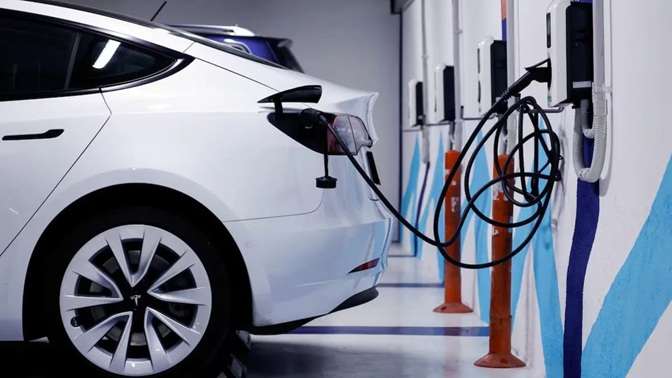After a lukewarm 2024, the global electric vehicle (EV) market is finally picking up serious speed in 2025. Fresh data shows EV sales — which include both battery-electric vehicles (BEVs) and plug-in hybrids (PHEVs) — are hitting new highs across major markets worldwide. But even as the numbers look promising, there’s a shadow on the horizon: looming changes in government policies, potential subsidy cuts, and new tariffs that could pump the brakes later this year.

Global EV Sales Hit New Highs in Q1 2025
According to figures from EV analytics firm Rho Motion, the first quarter of 2025 saw approximately 4.1 million electrified vehicles sold worldwide. That’s a huge 29% jump compared to the same time last year — a clear sign that interest in EVs isn’t just growing, it’s accelerating. Even in markets that were previously slow to catch fire, 2025 is proving to be a turning point.
🇺🇸 North America Shows Modest But Meaningful Growth
North America recorded sales of roughly 500,000 electrified vehicles in Q1, which is up 16% year-over-year. While the exact breakdown between BEVs and PHEVs isn’t disclosed, Cox Automotive and Kelley Blue Book data shows that pure EVs alone accounted for 296,227 sales in the U.S. — a healthy 11.4% increase over last year’s first quarter. Not explosive growth, but a steady climb that’s hard to ignore.
🇪🇺 Europe Ramps Up Even Faster
Europe’s growth was even more impressive. In the first three months of 2025, the continent logged sales of 900,000 electrified vehicles, marking a 22% increase overall. BEVs in particular saw a 27% jump, while PHEVs followed with a more modest 10% boost.
Some countries saw dramatic growth:
- Italy: +64% EV sales
- Germany: +34%
- United Kingdom: +42%
Clearly, European drivers are embracing the shift to electric with more confidence than ever.
🇨🇳 China Continues to Dominate the Global EV Market
Unsurprisingly, China remains the heavyweight champion of the EV world. A staggering 2.4 million EVs and PHEVs were sold in China during Q1 2025 — a 36% increase over the same period last year.
The sheer scale of the Chinese market makes it a key driver of global EV trends. And with homegrown giants like BYD, XPeng, and Nio leading the charge, China is showing no signs of slowing down.
Here’s a clear and engaging table summarizing Q1 2025 EV and PHEV sales by region, based on the data from your article:
Q1 2025 Electrified Vehicle Sales by Region
| Region | Total Sales (EVs + PHEVs) | Year-over-Year Growth | Highlights |
|---|---|---|---|
| Global | 4.1 million | +29% | Strongest global Q1 to date for electrified vehicles |
| USA | ~500,000 | +16% | 296,227 pure EVs sold (+11.4% YoY); PHEV breakdown not detailed |
| Europe | ~900,000 | +22% | BEVs +27%, PHEVs +10%; major growth in UK, Italy, and Germany |
| China | 2.4 million | +36% | Largest EV/PHEV market in the world |
| Rest of World | ~300,000 | +27% | Includes emerging markets; strong adoption momentum |
Other Regions Holding Strong
Outside the major markets, the rest of the world — grouped together in Rho Motion’s report — saw EV sales increase by 27%, totaling around 300,000 units sold. That includes emerging markets that are beginning to adopt electrified mobility in larger numbers.
What’s Fueling the Growth?
Multiple factors are behind the EV surge:
- Better charging infrastructure
- Improved battery tech and range
- More models across price points
- Government incentives and green policies
But one of the most interesting takeaways is that about 60% of EVs and PHEVs sold in the U.S. were made domestically. The rest mostly come from countries like Japan, South Korea, and Mexico.

Q1 2025 vs 2024 EV & PHEV SALES
| Region | Sales | Diff. vs 24 |
| China | 2.4 million | +36% |
| Europe | 0.9 million | +22% |
| North America | 0.5 million | +16% |
| Rest of World | 0.3 million | +27% |
| Global | 4.1 million | +29% |
Policy Changes Could Disrupt the Party
Despite the strong start to 2025, experts are warning that changes in policy — especially from the U.S. — could cause a slowdown.
The Trump administration’s new tariff plans could make imported EVs more expensive, and internal combustion engine (ICE) vehicles aren’t spared either. Plus, the removal of EV subsidies in countries like France has already led to a noticeable sales slump there — down 18% in Q1, according to Rho Motion. This shows just how sensitive EV demand is to government support. As those policies shift, sales may become more volatile.
Expert View
Charles Lester, Data Manager at Rho Motion, summarized the situation well:
“This quarter, while turbulent, has seen a strong rate of growth globally for the EV market. Some countries, such as the UK, had a record-breaking March as drivers continue to go electric. The removal of subsidies in France has had a shrinking effect on sales which are down 18%.” So while Q1 was a success, it’s not time to relax just yet.
EV sales are clearly gaining momentum in early 2025. Global numbers are strong, and consumers are showing more confidence in making the switch. But the industry isn’t out of the woods. Tariffs, subsidies, and shifting government priorities could easily shake things up in the coming months.
If 2024 was a year of stalled expectations, 2025 is shaping up to be a year of cautious optimism — full of potential, but also full of challenges. The electric revolution is still on, but it may have to navigate a few speed bumps along the way.




